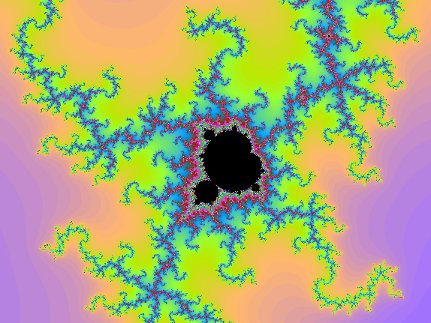While at linux.conf.au earlier this year, I started hacking on a Mandelbrot Set fractal renderer implemented in JavaScript as a way to polish my JS skills. In particular, I wanted to get to know the HTML5 Canvas and Worker APIs.
The results turned out pretty well. Click on the image below to try it out:
Clicking anywhere on the fractal will zoom in. You’ll need to reload the page to zoom out. Zooming in while the fractal is still being rendered will interrupt the previous rendering job.
All the calculations are done via web workers, so should not block the UI. The algorithms used to calculate these types of fractals are easy to parallelise, so it was not particularly difficult to add more workers. One side effect of this is that the lines of the fractal don’t always get rendered in order.
With Chromium, this maxes out all six cores on my desktop system. In contrast, Firefox only keeps three cores busy. As workers are not directly tied to operating system threads, this may just mean that Firefox allocates fewer threads for running workers. I haven’t tested any other browsers.
Browser technology certainly has progressed quite a bit in the last few years.

Pretty cool. I wonder how this performance compares to, say, Python. (Guile in my case; they are similar.)
I would be surprised if JS didn’t roundly beat Python or Guile on this one.
One thing I didn’t measure (and don’t really have a good way to measure) was the message passing overhead. The web worker specification says that the objects passed in messages between workers have to be serialisable as JSON.
This is because workers run in different interpreter instances to the main thread and the implementation won’t necessarily let you migrate objects between instances. So it is likely that some period of time is being spent on JSON encode/decode for each line generated.
If an alternative language has more efficient message passing, then that might let it beat the JavaScript implementation.
It’s funny, but not seem’s to be a real fractal as after some level of zoom (~ 15) the picture is Pixelise …
@Roumano: I think that is just a case of hitting the precision limit for the floating point type used by the interpreter. I’m not using any special high precision arithmetic library, so it isn’t surprising that that happens.
Hmm, if you implemented it more like Xaos it might be faster and nicer.
Pretty neat, a minor enhancement would be to start drawing lines up and down starting from where the user clicked, so you can immediately pinpoint where you are and click again if you can already see where you want to go next (instead of waiting for the whole thing to render). But I guess usuability wasnt the point of this demo :p
@foo: it isn’t surprising that a native code implementation runs faster. I was doing this more as a way to practice parallel programming in the context of browsers.
@Hans: I guess that would make things a bit nicer to use. It would probably only take a function to remap the value of the line counter when sending jobs to the workers.
Looks great, and nice code. With safari I’m maxing out 8 cores. Nice.
Eric
Hi, I really like your mandelbrot. I’ve done one recently in javascript in xhtml with svg, which works on Chrome and IE9 but is too intensive for Firefox. Mine is slower than yours. I haven’t learnt ‘canvas’ but you’ve got great results with it. For some reason I was getting the impression that canvas wasn’t supported by many browsers, but on my computer your version works fine on Chrome and FF. I didn’t use multiple precision arithmetic either, because I think the limits are imposed more by the iteration max (I used 2000, I think you used 1024), and the consequent calculation speeds, than the depth of zoom. Jake.
James can you contact me directly? I have a question for you (about publishing some of your code).
Thanks,
Eric
Jake, canvas is now widely supported by pretty much all modern browsers.
Eric
@Jake: I’d imagine the SVG method would be a fair bit slower and more memory hungry, since you’re asking the browser to create a DOM node for each pixel in the image, while with the canvas I just need to update the RGB image data associated with the single canvas element. You could still apply web workers to parallelise the calculation in your implementation.
While there are areas that are obviously lacking detail due to the iteration limit I set, there are other areas of the image where I hit the floating point precision limit first and the image becomes blocky. I imagine you could find areas in your version that exhibit this.
Thanks James and Eric for your comments, it’s helpful to understand some of these speed issues. I’ll get working on learning canvas.
Jake
Hi James,
I now have learned enough about Canvas to re-do my Mandelbrot generator using it. It is much faster, and I’m pleased with the result. I don’t know about web workers (I’m only a maths teacher), maybe that’s the next step. In case you want to try my Mandelbrot, here it is: http://www.jakebakermaths.org.uk/maths/mandelbrot/canvasmandelbrotv12.html. It works on Chrome, Firefox and IE9; I don’t know about Safari or Opera.
Jake.
Hi James,
thanks for the post
I slightly derived your code to try to make it more “education ready”.
http://www.framexpeditions.com/~alex2/teaching/mandelbrot/
Alex